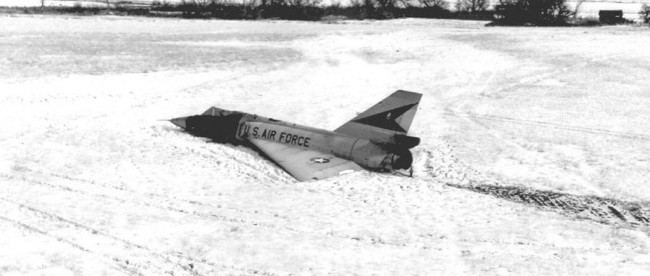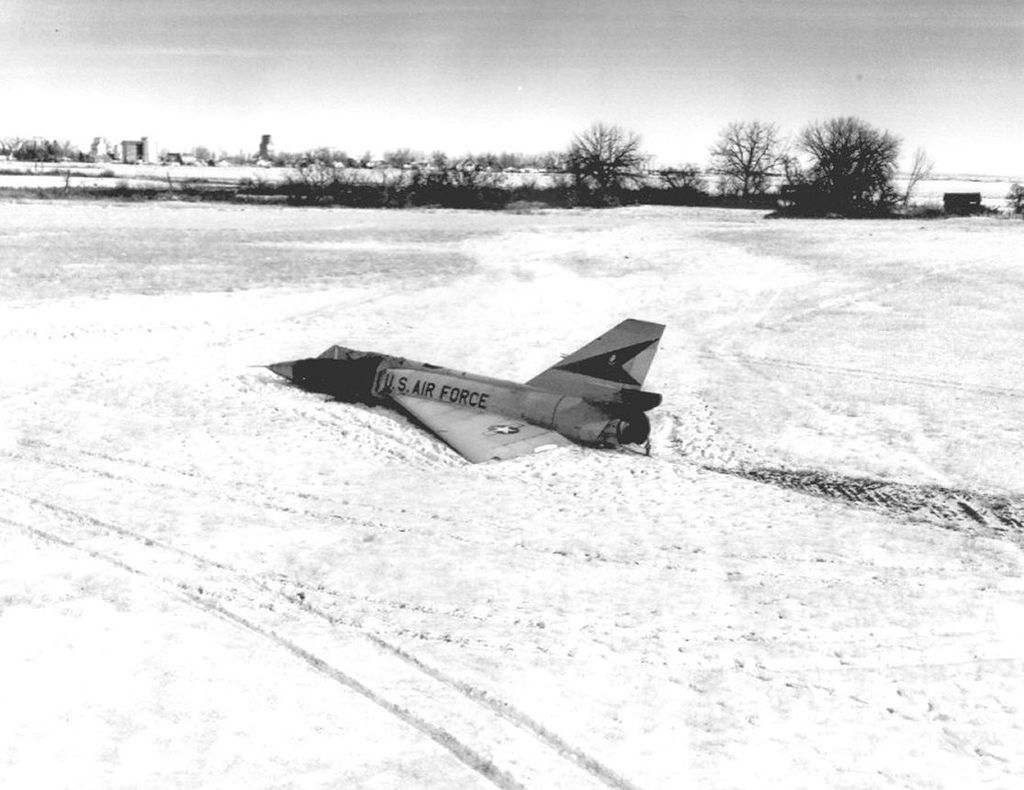How to Land a Plane By Leaving It

On February 2, 1970, a local sheriff in Montana arrived on the scene of an accident. But this wasn’t a run-of-the-mill car crash. First of all, the accident occurred in a frozen-over wheat field, leaving a trail of melted snow in its path. Second, no one else was anywhere near the field — and no, there were no dead bodies either. And finally, the vehicle wasn’t showing a lot of damage; in fact, with only minor repairs, it’d soon return to where it came, fully in use.
Oh, and the vehicle wasn’t a car. It was a jet fighter.
Earlier that day, a squadron of Convair F-106 Delta Darts — the one in question is pictured above — took off on a routine training mission from a base near Great Falls, Montana. The training flight called for a series of aerial maneuvers, but for one plane — tail number 58-0787 — something went wrong. The plane ended up in a flat spin and likely doomed to crash. The pilot, Gary Foust, followed the standard procedures, which according to a Delta Dart fan site (the Internet has everything, doesn’t it?), effectively meant that he took his hands off the stick and put the plane in a setting similar to takeoff. The hope was that the plane would somehow level itself out, but not so in this case. Unsuccessful, Foust ejected from the plane.
And then something unexpected happened — the plane, now pilotless, leveled off.
As online aviation magazine Historic Wings explained, “when Captain Foust ejected, the blast force of his seat rocketing out of the plane pushed the F-106′s nose down, instantly breaking the stall and spin.” Further, Historic Wings notes, the pre-ejection procedures Foust had just employed “left the plane in a roughly good configuration for a steady gliding descent.” The Convair, which seemed destined to meet its end in a fiery explosion, instead landed relatively safely to the surprise of Foust and his fellow pilots — even though no one was at the controls.
The plane was nicknamed the Cornfield Bomber (which is doubly wrong, as it landed in a wheat field and was a fighter plane, not a bomber) and survived to fly again. The repairs it needed were minimal, per Wikipedia, and the Convair remained in service for almost twenty more years. It now on display at the National Museum of the United States Air Force in Dayton, Ohio.
 Bonus Fact: In the late 1970s and into the early 1990s, NFL quarterback Joe Montana was a household name throughout the United States. He also had a last name which was the same as one of the fifty states, although there isn’t a town named Joe in the state of Montana — at least not anymore. In 1993, the town of Ismay, Montana (population 22 at the time) voted to change its name to Joe, at least for the remained of that NFL season. They even retiled the floor of the community center to reflect the new name, as seen here. Joe Montana retired after the 1994 season and Joe, Montana reverted to Ismay, Montana sometime thereafter.
Bonus Fact: In the late 1970s and into the early 1990s, NFL quarterback Joe Montana was a household name throughout the United States. He also had a last name which was the same as one of the fifty states, although there isn’t a town named Joe in the state of Montana — at least not anymore. In 1993, the town of Ismay, Montana (population 22 at the time) voted to change its name to Joe, at least for the remained of that NFL season. They even retiled the floor of the community center to reflect the new name, as seen here. Joe Montana retired after the 1994 season and Joe, Montana reverted to Ismay, Montana sometime thereafter.
From the Archives: Seeing is Disbelieving: A really smart observation about fighter planes which has applications to lots of other aspects of life.
Take the Quiz: Name the 20 largest cities in Montana. This is basically impossible unless you really, really know Montana.
Related: A pair of toy gliders for about $6. From experience, they’re not very durable but they’re fun while they last. (For some reason, Amazon has the at a list price of $90 with a 90% discount, but that has to be a mistake. And yes, I know I featured this two days ago with the exact same description, but it really is a good toy.)

